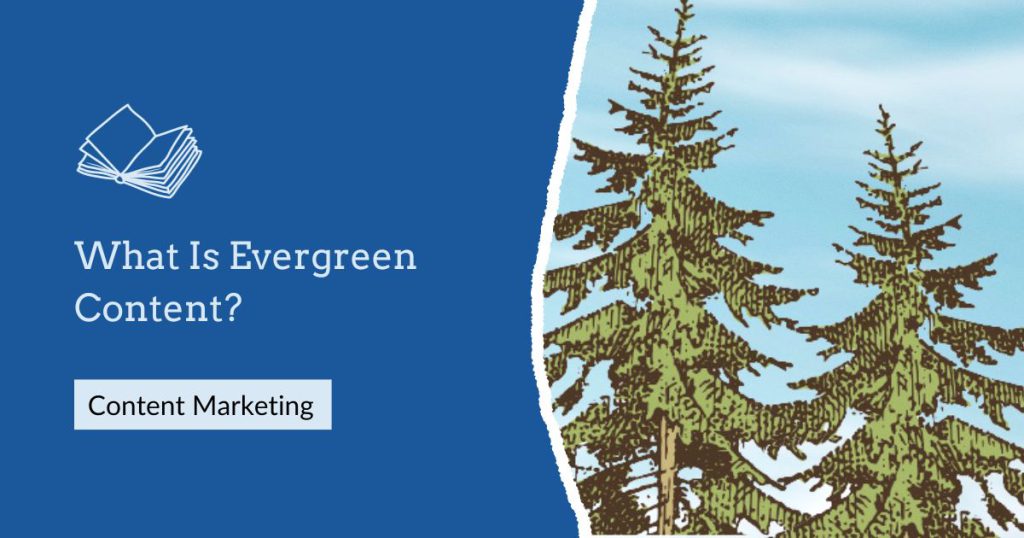What is Evergreen Content: The Ultimate Guide To Creating Content That Lasts
Content is king. Marketing gurus of all kinds bang on about how content is key to your overall marketing strategy.
Content is vital for SEO, social media marketing, email marketing, sales, customer service, and so much more.
But when the optimal article length is 2100 words long, coming out with high-quality content can be an issue.
This is where Evergreen content comes into play.
What is Evergreen Content?
Evergreen content is just like the tree – it always stays fresh. Evergreen content remains relevant and useful for an extended period of time.
Sure, your content might need a bit of a refresh now and again as new information or data comes out. But, evergreen trees need a bit of upkeep to stay alive and at a manageable size.
Evergreen content is a core part of content marketing – a strategy which uses media to educate, inform and entertain your potential customers.
What Makes Content Evergreen?
Evergreen content is a blog post, infographic, podcast or other medium that isn’t time-specific.
Evergreen content is not:
- News Articles
- Seasonal pieces that relate to a particular year
- Fads
- Fashion Trends
- Statistical data that’s likely to change
- Information on products with a run of a few months
Evergreen Content is:
- Information about long-term products
- How-tos, tutorials or walkthroughs
- Customer case studies
- Staff Interviews
- Top Tips
- Top 10s
- Ultimate guides
Why Is Evergreen Content Effective?
Evergreen content helps your content in a multitude of areas and has long-lasting effects.
As it lasts the distance, you have the opportunity to continue to promote, improve and optimise your post for success.
SEO
Evergreen content will grow exponentially over time. You can direct backlinks to your content, as well as some well-structured internal links.
Your content piece should focus on one or two keywords, and a handful of Latent Semantic Indexing (LSI) keywords. LSI keywords are keywords that search engines knows are linked to the content. For example, an article with the keyword “Best Laptop Computers” will have LSI keywords of “Notebook”, “Macbook”, or “Windows”.
Evergreen articles are brilliant for building backlinks too. As the information won’t go out of date, writers are more likely to link to it as a source.
Over time, your content piece will rank highly in search results and bring in traffic.
Social Media
Evergreen content is an easy win for social media. It’s a content piece that you can post over and over again, and it will always be relevant.
If you have a social media scheduler with a content queue feature, you can add your evergreen content to post multiple times over a set period. We recommend sharing it once a month as a maximum to avoid audience fatigue.
Email Marketing
Evergreen content is great for putting into broadcast emails. It gives a less sales-y promotion piece to keep your subscribers engaged.
Evergreen content is also perfect for automation emails. As the media stays fresh, it’s ideal for your “set and forget” emails, such as welcome campaigns.
How To Create Evergreen Content
Creating evergreen content that gets results can take time. But, as the results are longterm, it’s worth putting in the extra time.
1. Define your audience
First, you need to decide on who you are creating for. Do you want to create something for an expert in the field? Or a newcomer?
Then you need to look at their wants, needs and desires. What problems are they having that are stopping them from getting what they want or need? What does your audience struggle with that you need to solve.
So, if you sell partyware, your problems might be:
- Organising birthday parties for 10-year-olds
- How to make helium balloons last for a long time
- How to create a Castle Cake from scratch
2. Decide on Your Medium
You need to pick what medium your evergreen content is going to be. Are you going to do a:
- Podcast
- Blog Post
- Infographic
- Video
- Case Study
- eBook
- Something else?
3. Research your Keywords
Once you have a few problems you want to solve, it’s time to start your keyword research. Keyword research is a valuable process no mater what type of medium you are exploring.
You can be as thorough or quick as you like.
At an absolute minimum, type your article ideas into Google. The results will show you the types of articles that rank for those terms.
Pay attention to the article topics. Do the articles relate to your audience’s problems? If the articles are only loosely linked to the topic you want to cover, it might not be something to explore.
You should also pay attention to the “People Also Ask” box, to see any other relevant searches.
4. Evaluate the competition
Search for your keywords in Google and Bing. See what content is ranking for your term.
If you are looking at doing Video, you should also look at YouTube. If you’re looking to make a podcast, look at Spotify, Itunes and Sticher. If you’re looking at hosting on another platform, look at their internal search engines too.
Make a list of the:
- subheadings
- topics covered
- wordcount
- Linked sources and cited research
- Questions asked in the comments
You want to create content that is better and more thorough than what’s on offer (without plagiarising). This is known as Skyscraper content.
5. Find A List Of Questions Around Your Content
Once you have your topic, you need to look for questions to cover in your content. These will become your section headings.
Search your keyword on Quora and Answer the Public. Look through these questions and use them to guide your article.
6. Create A Content Outline
Create a basic framework for your post. You need to cover all the areas your audience needs to know about the subject. A simple framework might look like this:
- Introduction
- Paragraph 1 – What is X and why is it important
- Paragraph 2 – How does X lead to Y?
- List – 5 reasons X is key to your success
- Paragraph 3 – Next steps to start doing X
- Conclusion – Round up subject
7. Create Your Content
Your content needs to be long enough to cover everything you need, but short enough to be interesting.
Recommended word count for written pieces varies from niche to niche. But, research suggests that Google likes to see content around 2100 words. But don’t be daunted.
If you’ve completed step 4, you should have a list of word counts for top-performing articles. If you can’t hit 2100 words, aim to be 200-300 words higher than the highest word count.
For Podcasts and videos, longer content seems to work better, but you need to make sure your audience stays until the end. A lot of algorithms are based around retention, so keep an eye on your analytics to find the optimal time for your customers.
You might want to hire a content marketing agency or freelancer to help create your content piece. If you do decide to go down this route, make sure you research your options thoroughly.
8. Promote your content
Once your content is live, you need to start telling people about it. There are a huge amount of tactics to bring traffic to your website, like sharing content on social media, paid adverts, email marketing and more.
How Often Should You Post Evergreen Content?
You should be posting content as often as possible. In an ideal world, you’d be posting content daily. But that’s rarely possible, even in huge corporations.
At a minimum, aim to post content every week, and alternate an Evergreen content piece and a more time-relevant or news related article.

